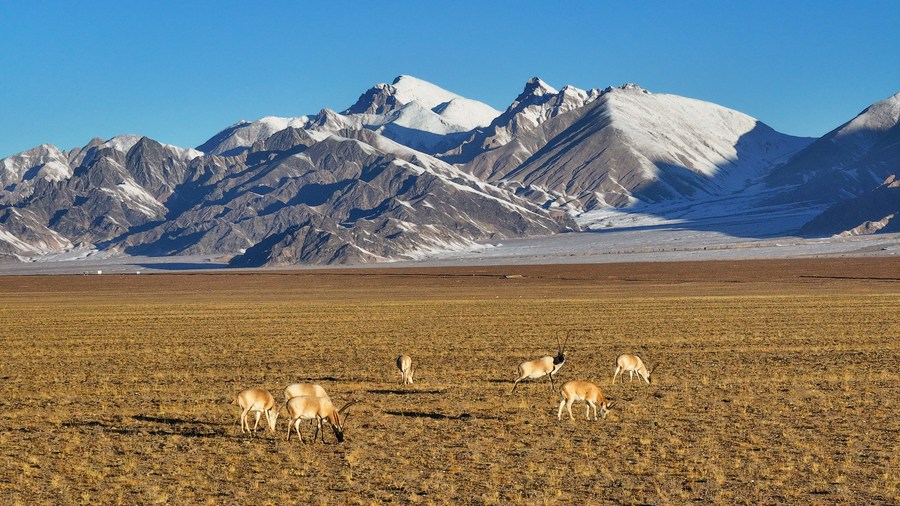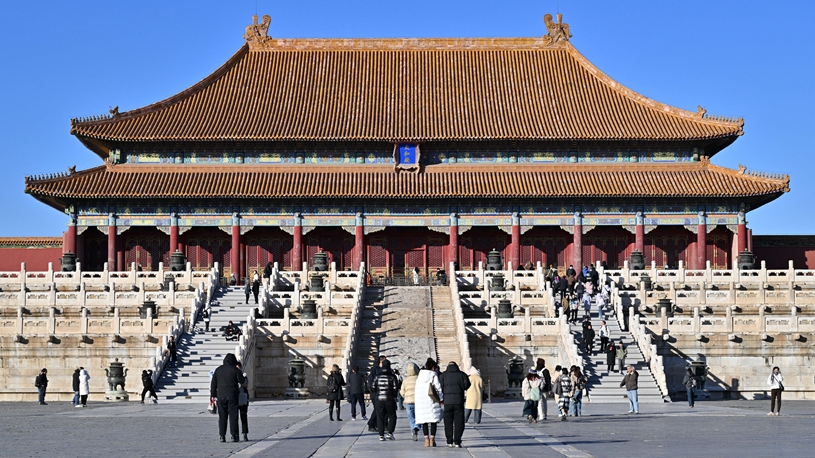*Nestled deep in the eastern Kunlun Mountains, the Altun Mountain National Nature Reserve boasts a distinctive plateau desert ecosystem. First established in 1983, it attained national-level status just two years later.
*Widely recognized as a "plateau gene bank," the reserve is home to over 300 wildlife and more than 380 plant species.
*Amid China's ongoing endeavors to build the world's largest national park system, relevant works are underway to create a national park in the Kunlun Mountains region. Experts believe the Altun reserve plays an important role in the establishment of the national park.
by Xinhua writers Li Ziliang, Li Xiang, Gu Yu and Su Chuanyi
URUMQI, Dec. 1 (Xinhua) -- The journey from Ruoqiang County in northwest China's Xinjiang Uygur Autonomous Region to the heart of the Altun Mountain National Nature Reserve takes about nine hours by car. The air is thin, the roads are challenging, and few people venture to the "secret land of Kunlun Mountains."
"Look! These wild donkeys are racing with us," Shang Peng, a ranger at the reserve, was thrilled at the sight of hundreds of Tibetan wild donkeys galloping behind the vehicle, kicking up clouds of dust.
Continuing eastward, Tibetan antelopes dotted an expansive grassland. Unlike donkeys, they halted when a vehicle passed by, lifting their heads simultaneously, ears alert, keenly checking for potential danger.
There is much more to discover as the journey unfolds in the nature reserve spanning 45,000 square km. "Our encounters with wild animals have increased over recent years, thanks to intensified conservation efforts that continuously enhance the eco-environment. The wildlife population and their habitats are constantly expanding," Shang said.
UNIQUE "GENE BANK"
Nestled deep in the eastern Kunlun Mountains, the Altun reserve boasts a distinctive plateau desert ecosystem. First established in 1983, it attained national-level status just two years later.
Widely recognized as a "plateau gene bank," the reserve is home to over 300 wildlife and more than 380 plant species. The total population of Tibetan antelopes, wild yaks and Tibetan wild donkeys here has exceeded 127,000, increasing 63.2 percent in 20 years.

This aerial photo taken on Oct. 18, 2023 shows Tibetan antelopes foraging at the Altun Mountain National Nature Reserve in northwest China's Xinjiang Uygur Autonomous Region. (Xinhua/Li Xiang)
In 2021, the Parnassia trinervis Drude, a plant known as the barometer of the plateau ecological environment, was discovered in the reserve for the first time by a scientific expedition team.
"In China, this plant had only been found in certain regions of the Qinghai-Tibet Plateau previously. It is highly sensitive to its surrounding environment," said Zhang Faqi, a researcher at the Northwest Institute of Plateau Biology, Chinese Academy of Sciences. "Its discovery in the reserve indicates that the local ecological environment is showing positive development."
The water area within the reserve has also been continuously expanding. The largest saline lake in the reserve, Ayakumu Lake, has witnessed a more than 60 percent increase in its water area over the past 30 years, expanding by over 500 square km.
While standing by the lakeside, Shang gestured towards a particular spot within the lake. "There used to be a stone tablet right there 10 years ago, situated on the former lakeside. Now, it is beneath the water," he explained.

This aerial photo taken on Oct. 18, 2023 shows the Ayakumu Lake and snow-covered mountains at the Altun Mountain National Nature Reserve in northwest China's Xinjiang Uygur Autonomous Region. (Xinhua/Li Xiang)
As the vehicle crested a small hill, everyone in the passenger seats remained immersed in the magnificent scenery. However, a loud car honk drew their attention to the road ahead, as a massive wild yak was rapidly approaching.
The honk successfully halted the animal less than 50 centimeters from the vehicle. With an abrupt swerve, the yak stopped and stared at the strange "intruders" for a while before reluctantly departing.
"Encounters like this with wildlife are commonplace during our patrols," said Bulimbatu with a laugh. Having worked for the Altun Mountain National Nature Reserve Administration for over a decade, he is adept at maneuvering the area.
Like Shang and Bulimbatu, reserve staffers stay far away from their families, safeguarding wildlife on the freezing and oxygen-deprived plateau, where the average altitude reaches 4,500 meters.
"To overcome challenging road conditions, we always need two vehicles and must bring winches and shovels before embarking on our patrols," Bulimbatu said.

This photo taken on Oct. 18, 2023 shows black-necked cranes at the Altun Mountain National Nature Reserve in northwest China's Xinjiang Uygur Autonomous Region. (Xinhua/Li Xiang)
According to Zhang Shengfa, head of a guarding station, the reserve has collaborated with over 20 domestic and international institutions and research organizations to carry out over 50 research projects. They have also undertaken three comprehensive scientific expeditions, compiling monitoring data on the trends of ecosystem restoration, changes in animal populations, and fluctuations in vegetation coverage.
INTENSIFIED CONSERVATION EFFORTS
Wildlife is the primary inhabitants of the reserve, with the Qimantag township government and guarding stations the only human settlements. However, this wasn't always the case in the past, as the ecological environment was once threatened by sheep herding.
Over a decade ago, the local government decided to implement policies, including returning grazing land to grassland and shutting down mining companies in the reserve. As a result, 113 households from Qimantag Township relocated to Ruoqiang County, beginning a new and modern life.
Melkai Turdi grazed in the reserve for a long time. After moving out, the ecological dividend of 60,000 yuan (about 8438.82 U.S. dollars) a year makes her feel reassured.
"With fewer sheep, the grassland naturally thrives, and we are also enjoying better and convenient lives," said the 62-year-old woman who also earns extra income from odd jobs.
The regional government of Xinjiang first released a document of regulations on the management of the Altun reserve in 1999 and revised it twice later, with the latest version released in 2020, providing a solid legal foundation for the sustainable development of the reserve.

This aerial photo taken on Oct. 18, 2023 shows Tibetan wild donkeys running on a grassland at the Altun Mountain National Nature Reserve in northwest China's Xinjiang Uygur Autonomous Region. (Xinhua/Li Xiang)
Amid China's ongoing endeavors to build the world's largest national park system, relevant works are underway to create a national park in the Kunlun Mountains region. Wuyun Batu, director of the Altun reserve, believes that the reserve plays an important role in the establishment of the national park.
"The Altun reserve spans from the Qinghai-Tibet Plateau to the Tarim Basin, with a vertical elevation difference of over 3,000 meters. This extensive and unique ecological system is highly representative," he said.
Zhang Yujun, director of the national park research center at Beijing Forestry University, highlighted the benefits of establishing a national park in addressing the issue of fragmented management in resource conservation and protecting the authenticity of the ecosystem to the greatest extent possible. The Kunlun Mountains, covering diverse natural habitats like the Rabbit Lake area, which serves as the birthing ground for Tibetan antelopes, stand to gain from this initiative.
"In the future, wildlife and plants will have a better living environment in the national park," Zhang said.
(Video reporters: Li Ziliang, Li Xiang, Su Chuanyi, Gu Yu, Shang Peng, Su Bo; Video editors: Jia Xiaotong, Wei Yin, Liu Yutian) ■












